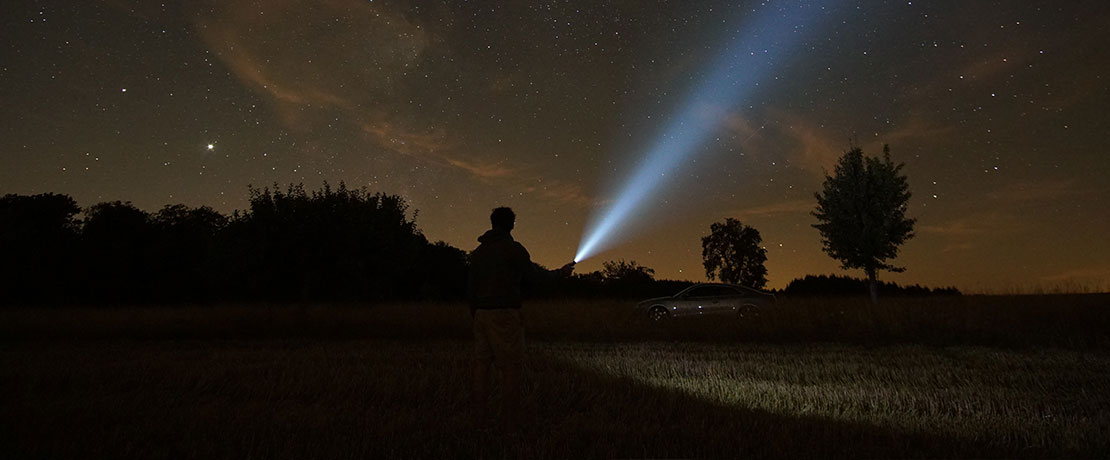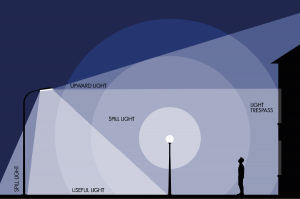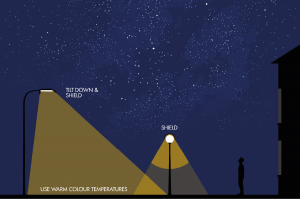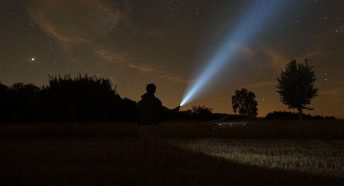10 things you may not know about light pollution
Here are some common misconceptions and facts about light pollution, written by the Commission for Dark Skies, British Astronomical Association.
Did you know that:
1. At least 30% of outdoor lighting is wasted, releasing atmospheric pollutants
Lamps that aren’t shielded allow light to escape uselessly into the sky, wasting electricity. The extra electricity generated by wasted light creates millions of tons of carbon dioxide per year. We need to reduce CO² emissions: poor lighting is increasing our emissions in the same way that some transport, food production and other activities do. Reducing light pollution is a much easier way to reduce emissions than many of the more difficult choices we face. A few simple changes can make all the difference.
Both sunlight and artificial light contribute to the formation of urban smog. Control of artificial lighting can help to lower NOx pollution, allowing natural darkness to aid the decay of harmful gases. Also, wasteful electricity production using fossil fuels causes extra air pollution.
2. In the UK, wasted lighting energy costs millions
Light pollution wastes electricity and therefore public money. It is difficult to know exact present or future lighting costs: the technology, prices and global demand change too rapidly. The only certainty: wasted light costs us all a lot. European dark-sky organisations suggest a figure for Europe of seven billion Euros1 annually. Before investing all our faith in alternative energy sources, we need to cut down on use and wastage, some of it caused by uncontrolled lighting.
3. Poorly designed and installed lighting causes glare and skyglow
Misdirected and tilted luminaires, often installed as sports, car park, domestic and commercial floodlighting2, cause waste light to be scattered in the atmosphere. Badly pointed lights allow high intensity beams to escape horizontally, the most troublesome form of scatter. LEDs can be particularly bad because of their blue-rich and often over-bright, concentrated light. Horizontal emissions are the main contributors to glare, light intrusion into premises, and skyglow. Glare causes discomfort and accidents, intrusion is very anti-social and skyglow stops us seeing the stars. All lighting should be shielded to point only downwards.
4. UK planning regulations cannot deal with poor lighting
In the UK planning system much outdoor lighting comes under the heading of ‘permitted development’ and is totally uncontrolled. But even when planning consent is required it is day-time aesthetic considerations that are assessed. The impact of the lights at night is often not considered, and neither is their intensity or aim. Further, there are no anti-light pollution design constraints on lighting manufacturers and distributors. You can still buy globe-on-post garden lights and dazzlingly bright so-called ‘security’ lights. Why is this allowed?
5. Brighter lighting does not mean improved security
Lighting and security don’t necessarily go hand-in-hand. Who benefits from an outdoor ‘security’ light left on in the early hours of the morning? Is it the resident, fast asleep in bed, the police officer in a car ten miles away or the burglar selecting his tools beneath the light? We read about ‘intelligent’ lighting, but lights have no moral discrimination, no bias: they will help both good guys and bad guys to see what they are doing.
6. Less lighting does not mean reduced safety
Many UK local authorities now switch off streetlights after midnight as a carbon and cost-saving measure. Local and national newspapers often pick up on public uncertainties about this: “PLUNGED INTO DARKNESS” or “SWITCH-OFFS – CRIME-WAVE FEARS”. However, research shows that dimming and switch-offs generally decrease crime rates and, if applied sensibly, have no effect on road accident rates. The media and some transport-related bodies continue to issue alarmist statements about these measures. They claim that darkness fosters criminality and causes road accidents. The science shows otherwise3.
7. More than half the world’s species are nocturnal and are potentially affected by lighting at night
Turning night into twilight or broad daylight can only be harmful to a vast range of night-active creatures which have been evolving for millions of years in harmony with the day-night circadian rhythm4: among countless examples are moths lured to their deaths by badly aimed lights, bats whose foraging ranges are severely reduced, and sea-turtle hatchlings disoriented and drawn to die inland.
Humans are causing the sixth great extinction: our artificial light is playing its part.
8. Excessive lighting at night should come with a health risk warning
The negative effects of inappropriate light exposure are causing concern in medical circles around the world. UK Government health advice states that “light intrusion by white/blue light is disruptive to sleep”. In 2009, the American Medical Association (AMA) forum voted unanimously to support efforts to control light pollution on the basis that “many species (including humans) need darkness to survive and thrive; glare from bad lighting is a public health hazard”. It passed a resolution calling for “all future streetlights to be of a fully shielded or similar non-glare design to improve the safety of roadways for all, but especially vision-impaired and older drivers”. Why does the AMA, a powerful and influential group, support light-pollution legislation? It cites glare from bad lighting as a public health hazard and a threat to biodiversity and humanity.
World authority on sleep disorders Dr Steven Lockley Ph.D.5 has written: “Measures to reduce light pollution are likely to have a beneficial effect on human health…the data suggest a detrimental effect of prolonged exposure.”
9. Governments can act to reduce levels of light pollution
In December 2018 the French government passed the first national all-embracing light pollution law regulating the direction, brightness and spectral character of exterior lighting of all kinds. Other countries and regions have regulated lighting practices. Given the current urgent need to reduce carbon emissions as our planet warms, and the evidence that waste light is a contributory factor in the rapid decline in biodiversity6, we should be urging all administrations, local and national, to tackle waste light.
10. The great majority of the world’s population cannot see the Milky Way
From where they live, about 90% of the world’s population cannot see the Milky Way, their home in the vast reaches of the universe. It’s a sad fact that the light from distant stars and galaxies takes hundreds, thousands, even millions of years to reach us. What a tragedy to lose it in the last millisecond of its journey.
For supporting information and references see the website of the Commission for Dark Skies, British Astronomical Association: www.britastro.org/dark-skies
References
- Based on satellite monitoring, numbers of lights and estimated efficiency.
- Often erroneously referred to as ‘security’ lighting.
- In July 2015, a study by The London School of Hygiene and Tropical Medicine and University College London showed that switch-offs do not increase car accident rates or crime: jech.bmj.com/content/69/11/111
- www.britastro.org/dark-skies/pdfs/CfDS_booklet_Rev07.pdf
- Neuroscientist and Assistant Professor of Medicine, Division of Sleep Medicine, Harvard Medical School.
- www.sciencedaily.com/releases/2018/06/180619122456.htm









